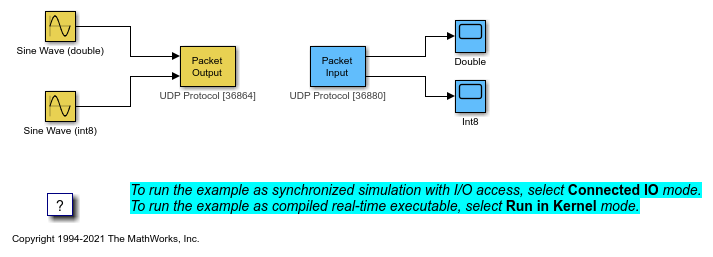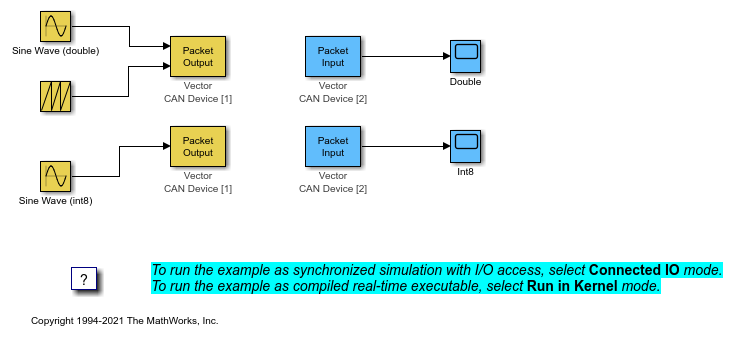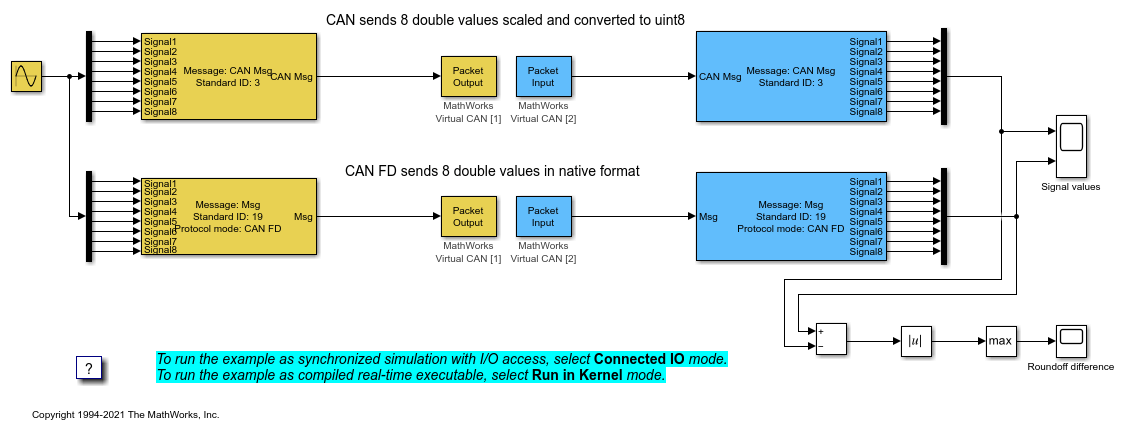Encoder Input
Read from one or multiple incremental encoder input channels
Libraries:
Simulink Desktop Real-Time
Description
The Encoder Input block connects to and reads from specific encoder input channels into your Simulink® model. After you have added an Encoder Input block to your model, you can enter the parameters for its I/O driver.
Examples
Packet Input/Output
Transfer data through UDP communication protocol using binary encoding.
CAN Input/Output with Vehicle Network Toolbox
Transfer data through CAN bus by using the CAN Pack and CAN Unpack blocks available in Vehicle Network Toolbox™ block library.
Ports
Output
Data representing the state of an encoder. The data type and range of the output values depend upon the capabilities of the board.
Data Types: single | double | int8 | uint8 | int16 | uint16 | int32 | uint32
In Connected IO mode, returns the number of timer ticks that your model lags behind the real-time kernel. When the model lags by more than Maximum missed ticks, the software reports an error and simulation stops.
Dependency
When you select Show “Missed Ticks” port, this port is visible.
Data Types: double
Parameters
When you click Install new board, the software displays a list of manufacturers of supported boards. When you select a manufacturer, the software displays a list of boards available from that manufacturer. When you select a board, the software adds the board to the list of registered boards and makes that board the current board.
By default, the initial selection in the list of registered boards is <
no board selected >.
For more information about driver support for I/O boards, see Hardware Support from Simulink Desktop Real-Time.
Dependency
When you select a board in the list of registered boards, the Delete current board and Board setup buttons are available.
Programmatic Use
Block Parameter:
DrvName |
To delete the current board, click this button. The initial
selection of the list of registered boards changes to <
no board selected >.
Dependency
To activate this parameter, select a board in the list of registered boards.
When you delete the current board, the Delete current board and Board setup buttons are no longer available.
Programmatic Use
Block Parameter:
DrvName |
To set up the board, click this button.
A board-specific dialog box opens to set up the board. For more information, see the board manufacturer documentation.
Dependency
To activate this parameter, select a board in the list of registered boards.
To deactivate this parameter, click Delete current board.
Programmatic Use
Block Parameter:
DrvAddress |
Block Parameter:
DrvOptions |
Enter a value, in seconds, that represents how frequently you want the block to execute and interact with the I/O hardware. The block synchronizes your model with the real-time clock at this sample rate.
If you are using a fixed-step solver, enter the value that you entered as the Fixed step size configuration parameter or an integer multiple of that value.
Programmatic Use
Block Parameter:
SampleTime |
In Connected IO mode, enter the number of timer ticks that your model can lag behind the real-time kernel. When the model lags behind by this number or fewer timer ticks, the software assumes that the lag is temporary. It allows the model to catch up, even if the model misses some ticks. When the model lags by more than this number, the software reports an error and simulation stops.
In Run in Kernel mode, the software ignores this value.
Programmatic Use
Block
Parameter:
MaxMissedTicks |
In Connected IO mode, select this check box to send the number of missed
ticks to output port Missed Ticks.
In Run in Kernel mode, the Missed Ticks port is
zero.
Programmatic Use
Block Parameter:
ShowMissedTicks |
In Connected IO mode, select this check box to grant other programs more CPU time while the kernel waits for a response from the hardware.
In Run in Kernel mode, the software ignores this value.
Programmatic Use
Block Parameter:
YieldWhenWaiting |
Enter a channel vector that selects the encoder input channels that you are using on this board. The vector can be any valid MATLAB® vector form. Each vector element corresponds to a channel on the selected hardware board in the same order as channels are numbered on the board. For example, to select the first four encoder input channels, enter:
[1,2,3,4]
or
[1:4]
Programmatic Use
Block Parameter:
Channels |
Encoders use two sets of stripes, shifted in phase, to detect optically the amplitude and direction of movement. This parameter specifies which encoder stripe edges the encoder counts. From the list, select:
quadruple(default) — Counts rising and falling edges from both stripe sets.double— Counts the rising edges from both stripe sets.single— Counts the rising edges from one stripe set.two-pulse— Counts the rising edges from two pulse encoder input with channel A input incrementing the count and input from channel B decrementing the count. This option is available when an NI-62xx or NI-63xx board is selected.
Quadruple mode yields four times more pulses per revolution than the single mode. Therefore, quadruple is more accurate. Use quadruple mode unless other parameters dictate otherwise.
Programmatic Use
Block Parameter:
QuadMode |
The encoder interface chip has a reset pin in addition to encoder inputs. Usually, you connect this pin to the index output of the encoder. However, you can connect it to any signal or not at all. This parameter specifies the function of this pin. From the list, select:
reset(default) — Level reset of the encoder count.gate— Enables encoder counting.rising edge index— Resets the encoder count on the rising edge.falling edge index— Resets the encoder count on the falling edge.
Programmatic Use
Block Parameter:
IndexPulse |
The encoder interface chip includes a low-pass filter that filters out high frequencies, which the chip interprets as noise. This parameter is the cutoff frequency (Hz) of this filter. The cutoff frequency that you specify is rounded to the nearest frequency supported by the chip.
If the encoder is moving slowly and high-frequency noise is
present, use the filter to eliminate the noise. With the filter in
operation, the chip does not count the noise as encoder pulses. If
the encoder is moving quickly, the filter can filter out the high-frequency
pulses, including pulses that you want to count. In this case, consider
disabling the filter by setting the cutoff frequency to Inf.
Programmatic Use
Block Parameter:
InputFilter |
From the list, select the type of data that the block outputs to the model. The valid values depend on the capabilities of the board.
Programmatic Use
Block
Parameter:
DataType |
Version History
Introduced before R2006aIn R2024b, when you enable optional ports, such as Show "Missed Ticks" port, these Simulink Desktop Real-Time™ block ports appear with labels.
The Encoder Input block Quadrature mode parameter supports selecting two-pulse mode when using a National Instruments™ 62xx or 63xx I/O board.
The Encoder Input block has an added option to select encoder phase for index pulse to the National Instruments PCI-62xx and PCI-63xx board drivers
See Also
Topics
MATLAB Command
You clicked a link that corresponds to this MATLAB command:
Run the command by entering it in the MATLAB Command Window. Web browsers do not support MATLAB commands.
选择网站
选择网站以获取翻译的可用内容,以及查看当地活动和优惠。根据您的位置,我们建议您选择:。
您也可以从以下列表中选择网站:
如何获得最佳网站性能
选择中国网站(中文或英文)以获得最佳网站性能。其他 MathWorks 国家/地区网站并未针对您所在位置的访问进行优化。
美洲
- América Latina (Español)
- Canada (English)
- United States (English)
欧洲
- Belgium (English)
- Denmark (English)
- Deutschland (Deutsch)
- España (Español)
- Finland (English)
- France (Français)
- Ireland (English)
- Italia (Italiano)
- Luxembourg (English)
- Netherlands (English)
- Norway (English)
- Österreich (Deutsch)
- Portugal (English)
- Sweden (English)
- Switzerland
- United Kingdom (English)


